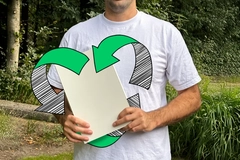CDP launches plastics disclosure platform to aid industries in greenwashing fight

20 Apr 2023 --- The Carbon Disclosure Project (CDP) has opened its global environmental disclosure platform for 2023, allowing companies across sectors to disclose their plastic-related impacts for the first time. The platform allows brands in the fashion, packaging and textile industries to disclose their plastic pollution to generate transparency and discourage greenwashing.
The fashion industry uses 342 million barrels of petroleum to produce plastic-based fibers such as polyester, nylon or acrylic, according to the Ellen MacArthur Foundation.
Through the CDP’s online disclosure platform, companies will disclose information on the production and use of plastics – including plastic polymers, durable plastics and plastic packaging. The data will be made available in September.
“The link between plastic use, pollution and the fashion industry is increasingly understood and with it, rising pressure on fashion companies to address this from consumers, investors, NGOs and governments alike,” Cate Lamb, global director for water security at CDP, tells PackagingInsights.
Innova Market Insights reported “green but clean” as a top packaging trend of 2023. Consumers want sustainability, but they don’t want to be misled. The market researcher flagged that the proliferation of sustainability messaging has created fears of unsubstantiated claims.
 Fashion textiles are one of the largest contributors to marine microplastics. Understanding risk
Fashion textiles are one of the largest contributors to marine microplastics. Understanding risk
Plastic-related disclosure, such as that offered by CDP, is a widely accepted method for fashion textile and packaging companies to inform this diverse audience of stakeholders about the steps they are taking to address the issues.
Recently, the beverage industry associations called on EU policymakers to prevent “free-riding” fashion businesses from disrupting the circular economy by using the recycled plastic supply without contributing a fair share.
It was reported that fashion companies boost their environmental credentials by buying beverage packs produced by rPET, thereby creating an illusion of circularity for public relations purposes. As a result, the price of rPET has more than doubled over the past year.
Misrepresenting plastic usage is what CDP aims to mitigate through standardized questions that put fashion businesses on the same playing field across sectors that use plastics.
Lamb acknowledges that it may be difficult for some fashion brands to disclose plastic-related data for the first time but hopes its previous participants, H&M, GAP and Kering, will set an example for brands to follow.
“At the moment, a majority of companies (and their investors) don’t understand how they contribute to the plastic pollution crisis and the financial, commercial, legal and reputational impacts, opportunities and risks they face as a result,” he says.
“Plastic-related disclosure will support fashion packaging companies to understand their impacts on the environment and the risks and opportunities facing them. Understanding these risks enables them to act to mitigate them.”
Lamb explains that companies should disclose their plastic use as a response to investor pressure – which is increasing as investors acknowledge the risks to get ahead of regulation as more countries introduce restrictions on plastic products and recycling, to improve their reputation and take advantage of the economic opportunities associated with a circular economy.
Transparency in the fashion industry  CDP gives a way for fashion to be more transparent with their plastic use.
CDP gives a way for fashion to be more transparent with their plastic use.
Disclosure through CDP’s system is standardized, with every company incentivized to fill out the same most pertinent questions, meaning that data is comprehensive and comparable from company to company.
“Transparency and accountability are critical. Disclosure will also ensure that companies’ efforts to eliminate plastic pollution can be effectively tracked and they can be held to account for their progress (or lack thereof) by their stakeholders – from regulators and investors to consumers.”
Lamb says the method allows for less room for greenwashing as it takes the reporting away from companies, allowing them to set their narrative and cause difficulties in comparison.
“In this case, CDP has worked with experts in this area, and our questions build off existing best practices and frameworks, including the Ellen MacArthur Foundation and the United Nations Environment Programme Global Commitment,” adds Lamb.
Fashion pollution
According to the Ellen MacArthur Foundation, every second, the equivalent of a truckload of clothes is burnt or buried in a landfill.
Additionally, Matter Of Trust reports that half of the garments from leading fast fashion brands are made of non-recycled plastics like polyester and nylon. “Many apparel companies have been slow to transition to recycled materials – for some online stores, just 1% of items contain recycled materials,” asserts Lamb.
“Every time these garments are used or washed, they shed millions of plastic microfibers, which pass through wastewater treatment plants and end up in the ocean. The apparel sector is one of the major contributors to microplastic pollution in our oceans,” Lamb concludes.
By Sabine Waldeck











